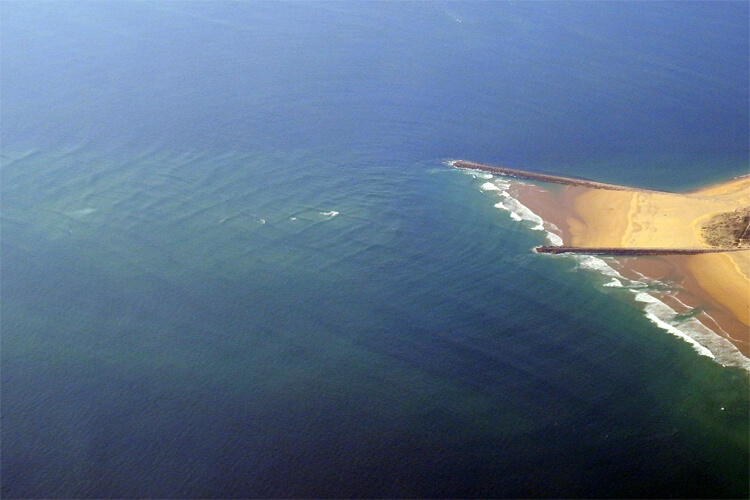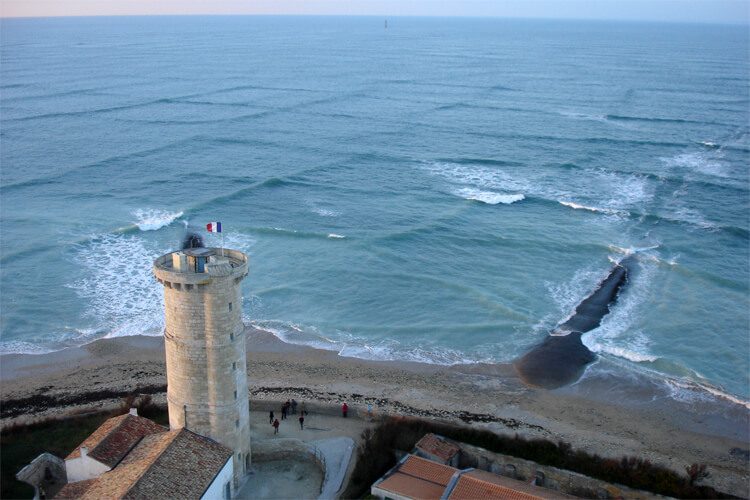Have you ever spotted a quadrilateral-shaped wave pattern in the ocean? If so, you've witnessed square waves.
Most waves reach the shore and break horizontally and parallel to the coastline.
However, in some regions of the world, you may notice the creation of a chessboard-like pattern on the surface of the water.
The phenomenon is rare yet extremely dangerous. Looking at these waves from above, it seems like there's an underwater grid forming square-shaped ripples.
You can easily spot the strange pattern by climbing to the top of a lighthouse or cliff or flying a drone over the area.
However, square waves do not result from any circumstance that is taking place below the water. Instead, they're the result of the way the water is moving.
In other words, square waves result from the intersection of two seas, also known as cross-sea or grid waves.
A weather pattern in the region causes the waves to form at different angles. When two opposing swells collide, a unique pattern emerges.

Cross Seas Are Extremely Dangerous
The look of square waves is impressive, but they're extremely dangerous, even in small swell conditions.
If you see square waves in the ocean, get out of the water as soon as possible. Why? Because the phenomenon is usually associated with strong and localized rip tides.
Swimming or surfing in the middle of a cross-sea is not something you should be doing, even if you're an experienced swimmer or wave rider.
Cross swells can also cause boating accidents and shipwrecks.
Square-shaped waves are fascinating, but these criss-cross ripples pose a real threat to everyone and are too strong to get out of.
They can reach 10 feet (three meters) in height.
Cross seas are relatively rare and can appear and disappear within minutes on many beaches worldwide.
The most famous place in the world for watching square waves is Île de Ré - Isle of Ré - in France, as seen in the top picture.
The island, located off the coast of La Rochelle, is a tourist attraction even though cross seas only occur during certain times of the year.
Nevertheless, it has also been spotted in open waters in the South Pacific and the Atlantic Ocean.
The picture above shows the checkered wave pattern between two breakwaters near Lisbon, Portugal, but the occurrence has also been spotted at New Zealand's Whangamatā Beach.
On a small scale, it was also witnessed by SurferToday in Helsinki's Mustikkamaa island in Finland.
Square Waves and Shipping Accidents
As we've seen above, a cross-sea state is the result of several oceanographic phenomena taking place near the coastline, including:
- Wave Refraction;
- Wave Diffraction;
Wave refraction is the bending of swells and wave trains due to sudden and more or less changes in depth and bathymetry.
Wave diffraction is the bending of waves due to interaction with coastal features and obstructions like cliffs, headlands, or breakwaters.
So, when two wave systems create an oblique angle wave, it can interfere with shipping routes and cause accidents.
According to the European Space Agency (ESA), these square waves were responsible for a large percentage of ship accidents from 1995 to 1999.
Most of them occurred around the time fast temporal variations of sea state parameters were observed and when wind sea and swell were almost perfectly aligned.
In one of its scientific expeditions, the German research icebreaker vessel RV Polarstern detected and recorded a heavy rolling event created by square waves.
However, the introduction of the Synthetic-Aperture Radar (SAR) and its two-dimensional sea surface images helped detect potentially hazardous cross-sea scenarios, even in cloudy and adverse weather conditions.
